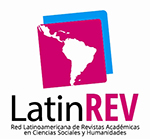INFORMATIONS
The RLE adopts a continuous submission model.
_____________
RLE is indexed in the Scopus database.

TOP 10 DOIs – February 2025
- 10.24140/ISSN.1645-7250.RLE40.13
- 10.24140/ISSN.1645-7250.RLE47.05
- 10.24140/ISSN.1645-7250.RLE40.15
- 10.24140/ISSN.1645-7250.RLE44.11
- 10.24140/ISSN.1645-7250.RLE54.03
- 10.24140/ISSN.1645-7250.RLE45.14
- 10.24140/ISSN.1645-7250.RLE41.03

RLE - doi:10.24140


LatinREV - Red Latinoamericana de Revistas Académicas en Ciencias Sociales y Humanidades

